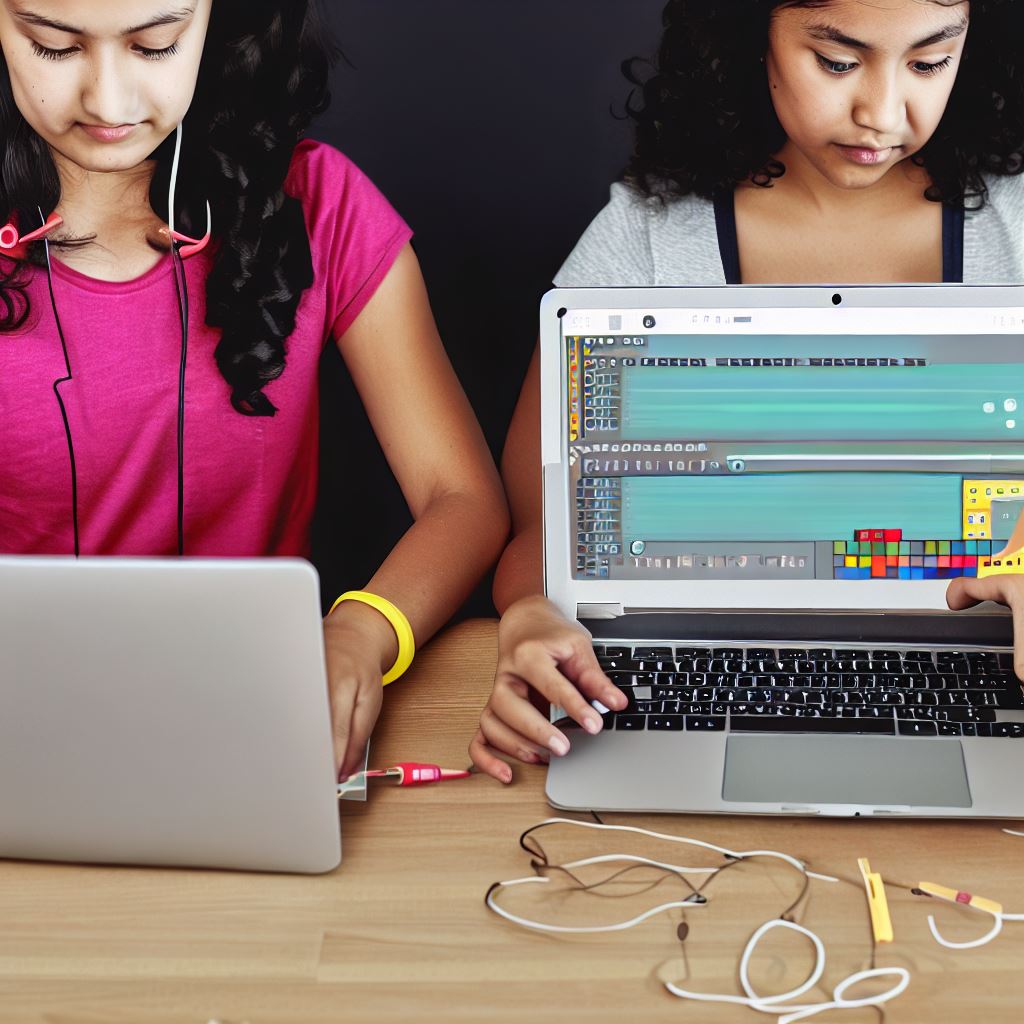Introduction
Brief explanation of Scratch
Scratch is a visual programming language designed to introduce coding concepts to children and beginners.
It allows users to create their own interactive stories, games, and animations by simply dragging and dropping code blocks.
Mention of the release of Scratch 3.0 and its significance
On January 2, 2019, Scratch 3.0 was released, which brought various new features and improvements.
Significance of Scratch 3.0
This new version of Scratch is significant as it enhances the overall coding experience and introduces exciting functions.
One of the major updates in Scratch 3.0 is the higher versatility of the coding blocks, providing greater flexibility in creating projects.
Additionally, Scratch 3.0 introduces a revamped interface, making it more user-friendly and intuitive for young learners.
It also incorporates extensions like micro:bit and LEGO MINDSTORMS EV3, expanding the possibilities of what can be created.
Furthermore, Scratch 3.0 supports HTML5, allowing projects to be easily shared and played on a variety of devices.
The new features include the ability to create custom blocks, control video sensing, and utilize text-to-speech functionality.
Scratch 3.0 promotes creativity, problem-solving, and collaborative skills among its users, empowering them to become digital creators.
With the release of Scratch 3.0, young coders and beginners can explore new possibilities in coding education.
The enhanced features and user-friendly interface significantly contribute to an enriching programming experience.
Scratch 3.0’s extensive range of extensions and new functions provide endless opportunities for creativity and innovation.
It is undoubtedly an exciting update that keeps Scratch at the forefront of educational programming tools.
Tech Consulting Tailored to Your Coding Journey
Get expert guidance in coding with a personalized consultation. Receive unique, actionable insights delivered in 1-3 business days.
Get StartedOverview of Scratch 3.0
Brief description of Scratch 3.0 and its history
Scratch 3.0 introduces several exciting new features and improvements to enhance the programming experience.
The development of Scratch began in 2003, with the first public release in 2007.
It was designed with the goal of empowering young people to express their creativity through programming.
Emphasis on the improved interface and user experience
One of the most noticeable changes in Scratch 3.0 is its revamped interface, which is more intuitive and user-friendly.
The new interface allows users to see more of their project while coding, making it easier to navigate and edit.
The drag-and-drop blocks, a hallmark of Scratch, have been redesigned to be more visually appealing and easier to understand.
The new extension system in Scratch 3.0 provides users with more flexibility and the ability to add new functionalities.
The improved sound editor allows users to compose their own sounds and add them to their projects.
With the updated paint editor, users can create and edit their own sprites and backdrops, giving them more creative control.
Scratch 3.0 also introduces new features like the text-to-speech block, which allows projects to speak out loud.
The new video sensing blocks enable users to create projects that interact with video feeds from webcams.
Additionally, the new pen blocks offer more control over drawing and animation capabilities within projects.
Read: Step-by-Step Guide: Making Your First AJAX Call
New Features in Scratch 3.0
In Scratch 3.0, several new features have been introduced to enhance the coding experience.
Block Palette
One of the notable additions is the Block Palette, which is now categorized for easier navigation.
The Block Palette in Scratch 3.0 is divided into sections such as Motion, Looks, Sound, and more.
This categorization allows users to quickly find the blocks they need for their coding projects.
With the categorized Block Palette, beginners can easily identify and understand the purpose of each block.
Introduction to extensions in Scratch 3.0 and their purpose
Extensions are another exciting feature in Scratch 3.0, allowing users to expand the capabilities of the platform.
Extensions can be added to Scratch to introduce new functionalities and interactions within projects.
For example, there are popular extensions like the Micro:bit extension, which enables interaction with external hardware.
By incorporating extensions into their projects, users can unleash their creativity and push the boundaries of coding.
Build Your Vision, Perfectly Tailored
Get a custom-built website or application that matches your vision and needs. Stand out from the crowd with a solution designed just for you—professional, scalable, and seamless.
Get StartedSound Editor
In Scratch 3.0, the Sound Editor introduces exciting features:
- Import: Easily import sounds for your projects, enhancing creativity and interactivity.
- Trim and Split: Precisely edit sound clips, trimming excess and splitting for seamless integration.
- Effects: Apply various effects like pitch, speed, and filters to create unique audio experiences.
- Layering: Overlap sounds to compose rich audio backgrounds, adding depth to your animations and games.
- Recording: Record your own sounds directly within Scratch, fostering originality in your projects.
- Library: Access a library of pre-loaded sounds, saving time and adding diverse audio elements.
With Scratch 3.0’s Sound Editor, you’ll unleash a world of auditory possibilities, making your projects more engaging and dynamic.
Overview of the new sound editor and its capabilities
The Sound Editor in Scratch 3.0 has also received significant improvements.
It now provides a comprehensive set of tools and capabilities for working with audio files.
The new Sound Editor allows users to import, edit, and manipulate sounds directly within the Scratch interface.
Tips on how to use the sound editor effectively
Users can add effects, adjust volume, and even create their own sound effects using the Sound Editor.
To use the Sound Editor effectively, it’s important to understand the various tools and their functionalities.
For example, users can use the noise filter to remove unwanted background noise from recorded sounds.
They can also utilize the pitch adjustment tool to change the pitch or tone of a sound sample.
Furthermore, users can layer multiple sounds, combine them, and create complex audio compositions.
With the new features in Scratch 3.0, coding becomes more intuitive and offers greater possibilities for creativity.
The categorized Block Palette makes it easier for users to locate and understand different coding blocks.
Extensions enable the integration of third-party functionalities, providing endless opportunities for unique projects.
The enhanced Sound Editor allows users to precisely work with audio files, resulting in more immersive projects.
Optimize Your Profile, Get Noticed
Make your resume and LinkedIn stand out to employers with a profile that highlights your technical skills and project experience. Elevate your career with a polished and professional presence.
Get NoticedScratch 3.0 empowers users, from beginners to advanced coders, to create interactive and engaging experiences.
Read: Stay Current: Coding Websites That Update Their Curriculum
How to Use the New Features
Step-by-step guide to using the block palette
The block palette in Scratch 3.0 is a versatile tool that allows users to easily create and customize their code. Follow these steps to effectively use the block palette:
- Open Scratch 3.0 and start a new project.
- Locate the block palette on the left side of the interface.
- Browse through the different categories of blocks to find the one you need.
- Click and drag the desired block onto the workspace.
- Connect the blocks together to form a sequence of instructions.
- Repeat the process for any additional blocks you want to add.
- Experiment with different combinations of blocks to achieve your desired functionality.
Instructions on how to add and utilize extensions in projects
Extensions allow Scratch users to expand the capabilities of the platform and add new features to their projects. Follow these instructions to add and utilize extensions:
- Open the Scratch 3.0 interface and start a new or existing project.
- Click on the “Choose an Extension” button located below the block palette.
- Browse through the available extensions and choose the one you want to add.
- Click on the extension to activate and enable it for your project.
- Once added, the extension’s new blocks will appear in the block palette for you to use.
- Explore the functionality of the extension by experimenting with its blocks and features.
- Utilize the extension’s capabilities to enhance your project and bring new elements to life.
Demonstration of the sound editor and its functions, including audio editing and importing sounds
The sound editor in Scratch 3.0 provides users with the ability to create and edit audio for their projects. Here’s a demonstration of its functions:
- Open Scratch 3.0 and navigate to the sound editor tab at the top of the interface.
- Click on the “Choose a Sound from Library” button to import pre-existing sounds.
- Alternatively, click on the “Record” button to directly record new sounds.
- Once on the sound editor, you can trim and adjust the imported or recorded sounds.
- Use the selection tools to choose specific portions of the sound to keep or delete.
- Apply effects and filters to alter the sound’s characteristics and create unique effects.
- Experiment with different editing options and play the edited sound to hear the changes.
- Once satisfied, save the edited sound and incorporate it into your Scratch project.
With these step-by-step guides, you can unleash the full potential of the new features in Scratch 3.0.
Take advantage of the block palette, extensions, and sound editor to enhance your coding and create engaging projects with ease.
Read: Why Minecraft is a Great Tool for Teaching Java

Examples of Creative Projects Using Scratch 3.0
Showcase of Creative Projects
In Scratch 3.0, users have created a wide variety of creative and interactive projects. Let’s explore some inspiring examples:
- Game Development: One project showcases a platform game where the player moves a character to collect gems and avoid obstacles.
It utilizes the new sprite customization feature to create unique characters. - Animation and Storytelling: Another project presents a captivating animated story with dialogue and scene transitions.
This project utilizes the new sound editing tool to add background music and sound effects. - Social Impact: An inspiring project addresses a social issue by raising awareness about pollution. It uses the new text-to-speech feature to deliver important messages to the audience.
New Features in Creative Projects
Each creative project makes use of the exciting new features introduced in Scratch 3.0:
- Block Palette Expansion: Projects take advantage of the expanded block palette, providing more possibilities for creating intricate animations and games.
- Sound Editing Tool: The new sound editor allows users to bring their projects to life by adding and editing sounds, making them more engaging and immersive.
- Sprite Customization: Projects utilize the enhanced sprite customization options to create unique characters that fit the theme and style of their projects.
- Text-to-Speech: The text-to-speech feature enables projects to communicate important messages and instructions effectively, enhancing user interactions.
Inspiration to Create your Own Projects
Seeing these creative projects in action can inspire readers to explore Scratch 3.0 and create their own projects:
- Unleash your creativity: Utilize the new features to bring your imaginative ideas to life, whether it’s designing a game, making an animation, or addressing a social issue.
- Experiment and learn: By exploring Scratch 3.0, you can learn coding concepts while having fun, discovering new techniques, and expanding your programming skills.
- Join the community: Engage with the vibrant Scratch community, share your projects, and learn from others. Collaboration and feedback will strengthen your abilities as a creator.
Scratch 3.0 introduces a wealth of new features that empower users to create innovative and engaging projects.
Through showcasing examples, highlighting the new features utilized, and inspiring readers to explore their own creativity, the possibilities with Scratch 3.0 are endless.
Read: The Basics of AJAX for Modern Web Development
Conclusion
Scratch 3.0 is packed with exciting new features that enhance the coding experience.
To recap, we discussed the major updates of Scratch 3.0, such as the revamped interface, the addition of new blocks, and improved support for touch devices.
Now, it’s time for you to take the plunge and start using Scratch 3.0 on your own projects. Don’t be afraid to explore its potential to its fullest!
Scratch 3.0 opens up a world of creativity and learning for users of all ages. It allows you to create interactive stories, games, and animations effortlessly.
By using Scratch 3.0, you’ll gain not only coding skills but also problem-solving abilities and logical thinking.
Imagine the impact Scratch 3.0 can have on the coding and educational communities. It empowers individuals to express their creativity and collaborate with others.
This updated version of Scratch has the potential to revolutionize coding education and inspire a new generation of young programmers.
Scratch 3.0 is an ideal platform to learn coding in a fun and interactive way. So, why wait? Start exploring Scratch 3.0 today and unlock your creative potential!




